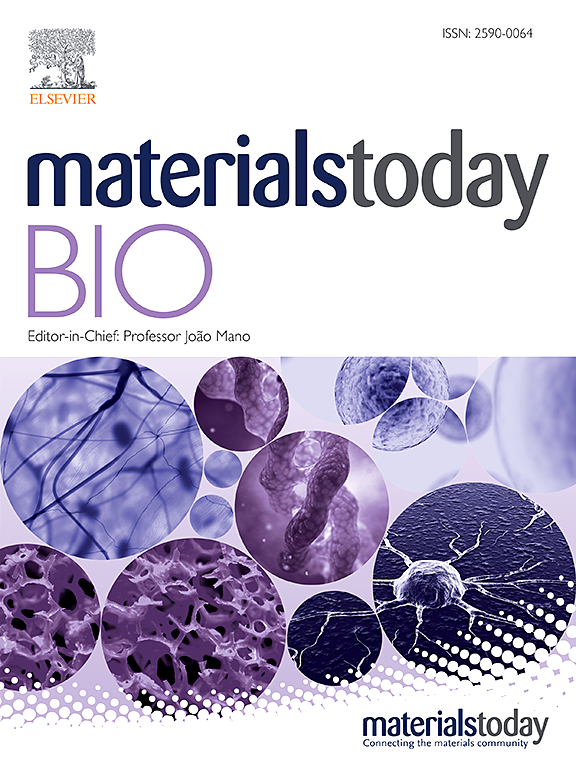具有协同抗菌和成骨功能的3d打印钛植入物肽平台,增强骨整合。
IF 8.7
1区 医学
Q1 ENGINEERING, BIOMEDICAL
引用次数: 0
摘要
创伤、感染或肿瘤引起的骨缺损是目前临床面临的主要挑战。钛(Ti)种植体因其优异的力学性能和生物相容性而被广泛应用;然而,它们的高弹性模量、低表面生物活性和对感染的易感性阻碍了骨整合并增加了失败率。对既能抵抗细菌感染又能促进骨整合的种植体的需求越来越大。在这项研究中,我们开发了一个肽平台来设计多功能3d打印Ti植入物(3DTi),该植入物由minTBP-1(靶向肽),KR-12(抗菌肽)和GFOGER(粘附肽)组成的融合肽修饰,称为3DTi- nfp。这种设计可以实现特异性靶向,局部递送,防止肽释放到循环中,并通过连接体保留功能完整性。在体外和体内感染骨缺损模型中,3DTi-NFP植入物均表现出良好的生物相容性,对金黄色葡萄球菌和大肠杆菌的杀菌效率均超过90%。植入物减少了细菌定植,同时增强了骨髓间充质干细胞(BMSCs)的粘附、增殖和分化,显著上调了成骨基因和蛋白质的表达。转录组测序进一步探索了3DTi-NFP协同作用的分子机制,揭示了局灶粘附和PI3K-Akt信号通路的激活,这些通路是细胞粘附、基质形成和新骨形成的关键因素。总的来说,这项研究为提高钛基植入物的长期成功率提供了一个有希望的策略,在组织再生和临床应用方面具有重要的潜力。本文章由计算机程序翻译,如有差异,请以英文原文为准。

Peptide platform for 3D-printed Ti implants with synergistic antibacterial and osteogenic functions to enhance osseointegration
Bone defects caused by trauma, infection, or tumors present a major clinical challenge. Titanium (Ti) implants are widely used due to their excellent mechanical properties and biocompatibility; however, their high elastic modulus, low surface bioactivity, and susceptibility to infection hinder osseointegration and increase failure rates. There is an increasing demand for implants that can resist bacterial infection while promoting osseointegration. In this study, we developed a peptide platform to engineer a multifunctional 3D-printed Ti implant (3DTi) modified with a fusion peptide composed of minTBP-1 (targeting peptide), KR-12 (antibacterial peptide), and GFOGER (adhesion peptide), termed 3DTi-NFP. This design enables specific targeting, localized delivery, prevention of peptide release into circulation, and functional integrity through linker retention. In both in vitro and in vivo infected bone defect models, 3DTi-NFP implants demonstrated excellent biocompatibility and achieved over 90 % bactericidal efficiency against S. aureus and E. coli. The implants reduced bacterial colonization while enhancing adhesion, proliferation, and differentiation of bone marrow mesenchymal stem cells (BMSCs), significantly upregulating osteogenic genes and protein expression. Transcriptome sequencing further explored the molecular mechanisms underlying the synergistic effects of 3DTi-NFP, revealing activation of the focal adhesion and PI3K-Akt signaling pathways-key contributors to cell adhesion, matrix formation, and new bone formation. Overall, this study provides a promising strategy to improve the long-term success of Ti-based implants, with significant potential for tissue regeneration and clinical applications.
求助全文
通过发布文献求助,成功后即可免费获取论文全文。
去求助
来源期刊

Materials Today Bio
Multiple-
CiteScore
8.30
自引率
4.90%
发文量
303
审稿时长
30 days
期刊介绍:
Materials Today Bio is a multidisciplinary journal that specializes in the intersection between biology and materials science, chemistry, physics, engineering, and medicine. It covers various aspects such as the design and assembly of new structures, their interaction with biological systems, functionalization, bioimaging, therapies, and diagnostics in healthcare. The journal aims to showcase the most significant advancements and discoveries in this field. As part of the Materials Today family, Materials Today Bio provides rigorous peer review, quick decision-making, and high visibility for authors. It is indexed in Scopus, PubMed Central, Emerging Sources, Citation Index (ESCI), and Directory of Open Access Journals (DOAJ).
 求助内容:
求助内容: 应助结果提醒方式:
应助结果提醒方式:


